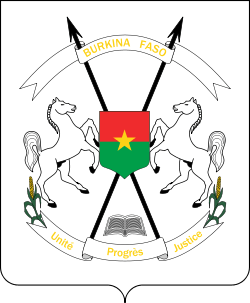Bura culture
Part of a series on the |
||||||||
|---|---|---|---|---|---|---|---|---|
| History of Burkina Faso | ||||||||
 | ||||||||
|
||||||||
|
||||||||
| Burkina Faso portal | ||||||||
The Bura culture (Bura system) refers to a set of archeological sites in the lower Niger River valley of Niger and Burkina Faso. More specifically, the Iron-Age civilization exemplified by the Bura culture was centered in the southwest portion of modern-day Niger and in the southeast part of contemporary Burkina Faso (formerly known as Upper Volta). [1] Iron industry, in both smelting and forging for tools and weapons, had developed in Sub-Saharan Africa by 1200 BCE.[2]
The first-millennium Bura-Asinda culture in the West African Sahel has been radio-carbon dated as starting in the 3rd century and lasting until the 13th century. But very little is precisely understood about this "shadowy" and "mysterious" civilization and its culture because it was discovered only a few decades ago in 1975; and it was not until 1983 that the first archeological excavation was commenced. [1]
Named for the Bura archeological site near Bura in southwest Niger, the Bura culture produced a variety of distinctive artifacts made of clay, iron and stone.[3]
However, it is not yet known how the entire Bura system linked up to other ancient African cultures and to such later Islamic-influenced Sahelian kingdoms as Ghana, early Mali, later Mali, or Songhai. [1]
See also
- History of Africa (emphasizes the pre-colonial civilizations)
- Ancient African history (emphasizes northeast Africa)
- History of West Africa (a brief summary)
- Muslim history (emphasizes culture and governance)
- Spread of Islam -- from 632 CE. onward
- Islam in Africa -- from 750 CE onward
- Islamic Golden Age -- from the 9th century to the 13th century
- Sahelian kingdoms such as:
- Kingdom of Ghana (a.k.a. Wagadou) -- from 790 to 1076
- Pre-Imperial Mali -- from c. 1000 to 1250
- Mali Empire -- from 1250 to 1610
- Songhai Empire -- from 1340 to 1591
- Nigerien culture -- that is, the contemporary Culture of Niger
- Burkinabé culture -- that is, the contemporary Culture of Burkina Faso
References
- ↑ 1.0 1.1 1.2 The Bura Archeological Site, UNESCO World Heritage Centre, translated into English
- ↑ Duncan E. Miller and N.J. Van Der Merwe, 'Early Metal Working in Sub Saharan Africa' Journal of African History 35 (1994) 1-36; Minze Stuiver and N.J. Van Der Merwe, 'Radiocarbon Chronology of the Iron Age in Sub-Saharan Africa' Current Anthropology 1968.
- ↑ Note the exhibits of Bura culture artifacts at the Hamill Gallery at and the Barakat Gallery at